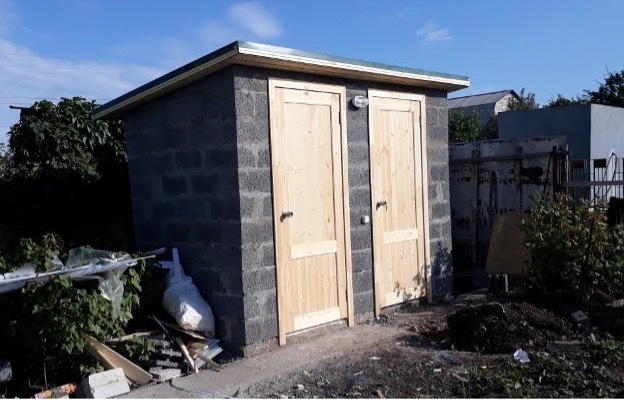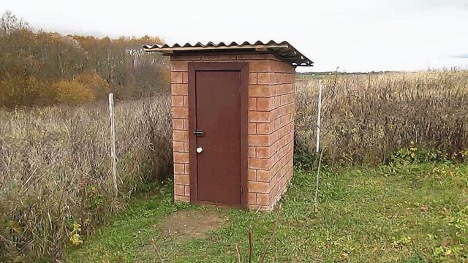Building a toilet from foam blocks is a cost-effective solution for a summer residence, due to the thermal insulation properties of the material and ease of installation. Foam blocks have a porous structure, which provides good insulation characteristics, but this may not be enough for winter conditions. Therefore, to maintain heat indoors during the cold season, additional insulation is necessary.

The content of the article
- How to achieve maximum thermal insulation
- The importance of floor and ceiling insulation
- Application of modern thermal insulation materials
- Windows and doors as critical elements
- Ventilation system to maintain comfort
- What should not be used as insulation for a winter toilet?
- Conclusion: a combination of insulation and functionality
How to achieve maximum thermal insulation
In order to make a warm toilet for your dacha, it is important to properly insulate the walls, floor and ceiling. Using foam blocks as the main material, you also need to provide additional insulation, such as mineral wool or expanded polystyrene. Such materials will help retain heat inside the room and ensure comfortable use of the toilet even in severe frosts.
The importance of floor and ceiling insulation
Insulating the floor in a winter garden toilet plays a key role in maintaining heat. Heat naturally rises, and if the floor is not insulated, cold from the ground will actively penetrate into the room, significantly reducing the air temperature inside. Using materials such as extruded polystyrene foam or mineral wool under a layer of waterproofing can significantly reduce heat loss through the floor.
The ceiling is another critical element in retaining heat inside a cottage toilet in winter. As warm air tends to rise, inadequate ceiling insulation will result in rapid loss of accumulated heat, thereby increasing the risk of condensation and increasing overall costs heating. Ceiling insulation must be designed to minimize heat transfer, which is especially important in low temperature conditions.
The integration of insulation into the design of a toilet made of foam blocks must be thoughtful and comprehensive. It is necessary to take into account all aspects of the interaction of various building materials, ensuring reliable hydro- and thermal insulation. From the choice of material to the method of its installation, every step should be aimed at increasing thermal efficiency and preventing freezing of the structure. This investment will not only increase the comfort of using a warm toilet for a summer residence, but will also extend the service life of the entire structure.
Application of modern thermal insulation materials
To ensure maximum efficiency in insulating a toilet made of foam blocks, it is important to choose the right thermal insulation materials. The modern market offers a wide range of insulating materials, each of which has its own unique properties and applications. Their choice should be based on criteria such as thermal conductivity, moisture resistance, durability and ease of installation.
Modern thermal insulation materials for insulating a winter toilet for a summer cottage:
-
Mineral wool:
- excellent heat and sound insulation;
- non-flammable material ensuring fire safety;
- durable and environmentally friendly.
-
Expanded polystyrene:
- lightweight and effective insulation;
- resistance to moisture and mold;
- easy to install and handle.
-
Extruded polystyrene foam (XPS):
- high thermal insulation characteristics;
- strength and moisture resistance;
- used for insulation of floors and foundations.
-
Penofol (foil insulating material):
- reflects thermal radiation;
- serves as an additional barrier to heat loss;
- lightweight and easy to install.
-
Glass wool:
- good thermal insulation and sound insulation properties;
- biostability, the material does not attract rodents;
- suitable for insulating walls and ceilings.
-
Styrofoam:
- low thermal conductivity;
- ease and simplicity of installation;
- economical option for insulation.
The choice of thermal insulation material for insulating an outdoor toilet should take into account the climatic characteristics of the region, the individual design features of the toilet and the budget. Investments in high-quality insulation today mean savings on heating and increased comfort in the future.

Windows and doors as critical elements
Do not forget about the quality of installed windows and doors. Even the most insulated garden toilet will lose its effectiveness if the doors and windows are not properly sealed. The use of double glazing and quality seals around door and window openings will significantly increase thermal insulation.
Ventilation system to maintain comfort
An effective ventilation system is necessary to prevent condensation and maintain a comfortable indoor climate. Even with careful insulation, without proper air circulation in a foam block toilet, humidity can increase, which creates unpleasant conditions for use and promotes the development of mold.
What should not be used as insulation for a winter toilet?
To insulate a winter toilet for a summer cottage, you should avoid using insulation materials. After all, they do not provide adequate insulation. They are also susceptible to damage from moisture or pests, and can also be a fire hazard. Foamed polyethylene is not the best choice due to its low thermal insulation properties. It also has the ability to deform at low temperatures. Natural fiber insulation, such as cotton or linen, although environmentally friendly, attracts rodents and absorbs moisture. And this leads to a decrease in their efficiency and the development of mold.
Also, do not use newspaper or other paper materials as insulation. After all, they quickly lose their thermal insulation qualities and pose a fire hazard. Expanded polystyrene may not be strong enough and is susceptible to mechanical damage, which reduces its durability. Insulation containing high levels of volatile organic compounds can be harmful to health due to the release of toxic gases. Metallized films without a base, although they reflect heat, will not be able to provide the required level of thermal insulation for an outdoor toilet in the winter without an additional layer of insulation.
Conclusion: a combination of insulation and functionality
Creating a winter toilet for a summer cottage requires a careful approach to insulation and the use of quality materials. A properly insulated and equipped bathroom will ensure comfortable use at any time of the year. In addition, taking into account environmental requirements and regulations, you can achieve not only comfort, but also safety for the environment.


